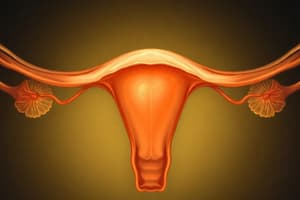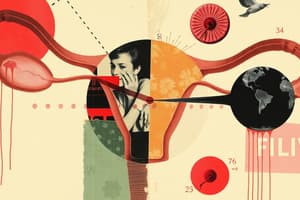Podcast
Questions and Answers
What is primarily produced by the corpus luteum after ovulation?
What is primarily produced by the corpus luteum after ovulation?
- Estrogen
- Progesterone (correct)
- Luteinizing hormone
- Testosterone
What happens to the levels of estrogen after the follicle transforms into the corpus luteum?
What happens to the levels of estrogen after the follicle transforms into the corpus luteum?
- Estrogen levels increase significantly
- Estrogen levels remain constant
- Estrogen levels fluctuate unpredictably
- Estrogen levels decrease greatly (correct)
What structure forms from the remnants of the follicle after ovulation?
What structure forms from the remnants of the follicle after ovulation?
- Endometrium
- Corpus luteum (correct)
- Ovarian stroma
- Graafian follicle
What is the role of progesterone after ovulation?
What is the role of progesterone after ovulation?
What is the name of the hormone that is primarily responsible for inducing the follicle to become the corpus luteum?
What is the name of the hormone that is primarily responsible for inducing the follicle to become the corpus luteum?
What phase follows ovulation in the menstrual cycle?
What phase follows ovulation in the menstrual cycle?
What is the egg called at the stage of implantation?
What is the egg called at the stage of implantation?
Which hormone is involved in decreasing after ovulation?
Which hormone is involved in decreasing after ovulation?
What role does progesterone play during the secretory phase of the menstrual cycle?
What role does progesterone play during the secretory phase of the menstrual cycle?
Which structure produces a large amount of progesterone during the luteal phase?
Which structure produces a large amount of progesterone during the luteal phase?
What effect does progesterone have on uterine muscle contractility?
What effect does progesterone have on uterine muscle contractility?
What happens when the corpus luteum begins to atrophy?
What happens when the corpus luteum begins to atrophy?
What hormone actively inhibits FSH release from the anterior pituitary?
What hormone actively inhibits FSH release from the anterior pituitary?
What physiological change signals the beginning of menstruation?
What physiological change signals the beginning of menstruation?
What is the primary function of spiral arteries in the endometrium?
What is the primary function of spiral arteries in the endometrium?
What effect does negative feedback from progesterone and estrogen have on FSH and LH production?
What effect does negative feedback from progesterone and estrogen have on FSH and LH production?
What hormone is produced by the embryo that helps maintain the corpus luteum during pregnancy?
What hormone is produced by the embryo that helps maintain the corpus luteum during pregnancy?
What is a common sign that pregnancy has not occurred?
What is a common sign that pregnancy has not occurred?
How long does menstruation typically last?
How long does menstruation typically last?
What happens to the corpus luteum if pregnancy does not occur?
What happens to the corpus luteum if pregnancy does not occur?
For how long does the corpus luteum primarily produce progesterone during pregnancy?
For how long does the corpus luteum primarily produce progesterone during pregnancy?
Why does menstruation not occur during pregnancy?
Why does menstruation not occur during pregnancy?
What role does the placenta play in pregnancy in relation to progesterone?
What role does the placenta play in pregnancy in relation to progesterone?
What effect does HCG have on the corpus luteum?
What effect does HCG have on the corpus luteum?
Which hormone is structurally similar to HCG and necessary for corpus luteum survival?
Which hormone is structurally similar to HCG and necessary for corpus luteum survival?
How do pregnancy tests typically work?
How do pregnancy tests typically work?
Flashcards are hidden until you start studying
Study Notes
Follicular and Luteal Phases
- The follicular phase focuses on stimulating growth of ovarian follicles, leading to ovulation.
- Key hormones involved in this phase include FSH (Follicle Stimulating Hormone), LH (Luteinizing Hormone), and estrogen.
- The luteal phase occurs post-ovulation; the remaining follicle transforms into the corpus luteum, a yellow structure.
Corpus Luteum and Hormonal Changes
- After ovulation, LH levels rise significantly, facilitating the formation of the corpus luteum.
- The corpus luteum produces progesterone in high quantities, although it also secretes some estrogen.
- Progesterone is essential for preparing the uterine lining (endometrium) for potential implantation of a fertilized egg.
Role of Progesterone
- Progesterone enhances blood flow to the endometrium through the development of spiral arteries, ensuring nutrient access for the embryo.
- It stimulates uterine secretions from glands that nourish the embryo.
- Progesterone decreases uterine muscle contractility to protect the embryo from expulsion during early development.
Feedback Mechanisms
- The corpus luteum's production of progesterone and estrogen suppresses FSH and LH secretion via negative feedback.
- Inhibin, produced by the corpus luteum, further inhibits FSH release.
Luteal Phase End and Menstruation
- When the corpus luteum atrophies due to decreased FSH and LH levels, progesterone and estrogen levels also fall.
- This drop triggers menstruation and shedding of the endometrial lining, marking the end of the luteal phase and the beginning of a new follicular phase.
- Average blood loss during menstruation is around 40 milliliters over two to seven days.
Pregnancy Implications
- If fertilization occurs, the embryo produces human chorionic gonadotropin (HCG), which mimics LH and sustains the corpus luteum.
- The corpus luteum continues to release estrogen and progesterone, maintaining the endometrial lining to support the pregnancy.
- Most pregnancy tests detect HCG levels to confirm pregnancy.
Transition to Placenta
- The corpus luteum is the primary source of progesterone for the first two to three months of pregnancy.
- After this period, the placenta takes over progesterone production, ensuring continued support for the developing fetus.
Summary of Outcomes
- If no pregnancy occurs, the corpus luteum deteriorates, restarting the reproductive cycle approximately every 28 days.
- If pregnancy occurs, the corpus luteum is preserved, preventing menstruation and allowing for the continued maintenance of the endometrial lining.
Studying That Suits You
Use AI to generate personalized quizzes and flashcards to suit your learning preferences.




